|
Seething-Fenland-Sherburn
Sunday 16th August 2009
In taking a peek at the Russian aerobatics team training at
Sherburn the previous Thursday, I found myself in the presence
of the best female pilots in the world, Svetlana Kapanina and Elena Kilmovich.
Saturday evening, torn between doing my flight
planning for Sunday and
a chance of meeting the team over Russian cuisine,
I decided to head for the aero club.
There I imposed my rusty Russian on a few patient souls
and discovered Svetlana was from Moscow and one
of her fellow pilots was from St Petersburg. I asked him how
the training was going. He advised
"We never get enough practice done before any event, but
the weather has been good here this week."
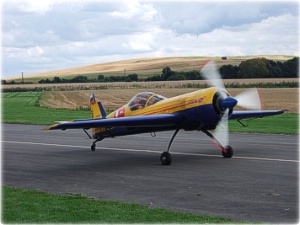
I left early
so that I could be up at 6.00 am the next morning to get the weather
reports and finish my flight planning for Seething.
The Red Arrows were going to be
very active around Britain. At about the time we would be flying from
Seething to Fenland they would be en route from Manston to
Scarborough via Marham and the Wash.
Back at Sherburn the following morning the Russian team
were in the throes of setting up for the day as I took off at
10.30 from 29-grass into a bumpy wind. At 400 feet I raised
the flaps before levelling out into smoother air at 1,000 feet.
We left the circuit via Eggborough and skirted underneath
Doncaster's CTA which starts
at 2,000 feet. As we were routing via Brough and the KIM NDB, co-pilot
Steve said goodbye to Sherburn and hello to Humberside.
He advised our route, altitude
and location but was challenged regarding the overhead transit. "Not at 1,800
feet!" declared the ATC.
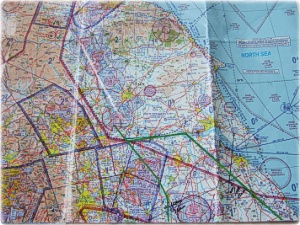
I realised I hadn't fully briefed Steve regarding my
flight plan and quickly advised I was going to ascend to 2,500 feet after Goole.
Steve re-negotiated the overhead crossing. My ETA for Brough was 10.58 and
we arrived at 10.56.
Before taking off I'd set the two VORs: one on the 070° radial from GAM, the
other on the 200° radial from OTR to get a position fix for Binbrook,
a field Steve was particularly interested in.
As I tracked a 155° heading
for Skegness (calculated with an average wind of 255°\29 factored in from
the F215) I soon realised the wind was not as strong as the forecast.
The visibility was so good I could see Elsham Wolds VRP as soon as I'd crossed
the Humber from Brough; the airfield was just beyond it. I kept to a heading
of 145° to keep me on track for Skegness from there.
At Elsham Wolds the Humberside ATC gave us the Humberside QNH of 1006
in order to safely transit above the field.
After we crossed he gave us the Barnsley QNH of
1009.
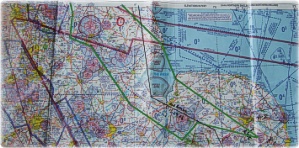
Having cleared Humberside I noticed the GAM VOR radial had come in
but the OTR VOR had flipped (i.e. we'd gone through it) without my noticing.
"Sorry", I declared, "but I think we've slipped past Binbrook".
Steve was tracking using his GPS and hadn't clocked eyes on it either.
He figured the surface had possibly been so churned up that it had become
indistinguishable from the rest of the terrain. At this point I did a FREDA
check and changed fuel tanks.
After Louth, as we approached Skegness, ATC advised of traffic to the south
of it so we decided to skirt around the eastern side of the airfield. Having
visited Skegness with another club member earlier in the summer I was able
to pick out the grass strips amidst the caravan park this time round.
My
ETA for Skegness was 11.18 and we arrived at 11.20. On reaching the Wash
Humberside advised us to contact Norwich and Steve said farewell. At the
windfarm just off the coast I changed to my heading for Hunstanton which
I could just about see through the haze.
As we reached the coast Steve called up Norwich Approach who asked us
to squawk 7370 and gave us the Yarmouth QNH of 1012. We arrived on time
at 11.30.
About ten minutes later we passed Skulthorpe to the north of us
and Steve explained it was an earmarked landing site for the Shuttle
(in case of emergency).
Next we passed
West Raynham to the south and
he explained was "Once home
to a Bloodhound missile launch site"
My mind reeled
with images of blood hounds homing in on our PA28. To bring my
thoughts back to earth I worked out the ETA was now around 11 minutes
for Seething.
Several minutes later we could just about make out some sheds and a flat
piece of land resembling an airstrip. Mm maybe my calculation was slightly
out; my ETA was 11.51.
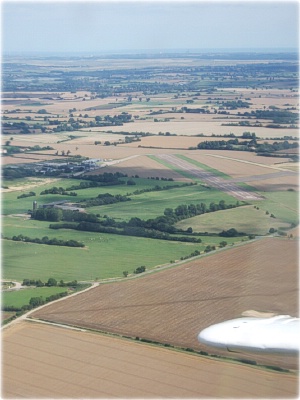
Steve studied his GPS. "It might be Seething". I decided to descend
to 2,000 feet in readiness to join on the dead side of
the circuit pattern.
At that point we heard a call on the radio - a TB10
was flying into Seething from Gamston and was at FL070. Norwich quickly
advised the pilot of traffic (us) to the north of Seething.
The pilot
responded by asking for a Traffic Service on his descent which was granted.
Now convinced we had the airfield in sight we requested a radio frequency
change to Seething Radio.
As we approached however it became very clear that this wasn't the
airfield; just a conglomeration of farm sheds and a level field in front.
Steve indicated the airfield should be in my eleven o'clock but I struggled
to make it out amidst the fields and woodland. A few moments later
Steve pointed it out; a rust coloured strip amidst all the brown fields post
harvest.
I'd already planned to descend on the dead side and cross the end of 06
(for 24 left hand) at 1,000 feet. As I approached I clocked the TB10 ahead
of us.
Shortly afterwards I started my descent onto the crosswind leg and
followed it onto the downwind leg. A minute or so after completing the
pre-landing checks I looked over my shoulder at the airfield; it was time
to turn onto base. The TB10 was well ahead of us so I figured he would be
down and clear of the runway before our landing.
I slowed down, lowered two stages of flap before turning onto final.
The runway perspective was looking good and my airspeed was nailed at 70
knots.
I announced I was on final and Seething Radio advised the wind
was 260°\15. "A slight cross-wind from the right hand-side", I thought to
myself and crabbed slightly to keep lined up with the runway.
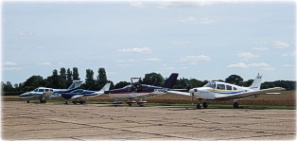
As I came
over the threshold I cut the power but flared a few inches too high. A
forgiving PA28 gently bounced on reaching the runway.
After landing we
were asked to exit left at hold Charlie and taxi up along the disused
strip to hold Beta; then across the active runway to hold Alpha and the
apron area.
Earlier in the week my friend Brian had warned me the parking
was tight. By good fortune a Cessna was just about to vacate so I slid in
behind the departing plane.
After I completed the shutdown checks at 12.05,
Steve jumped out and pushed Delta Bravo back to the edge of the drainage
gully running along the back of the apron, which made for an interesting
arrival on terra firma as I exited the plane.
It was a beautiful day and inside the spacious club we were greeted with
"What would you like to drink?" We ordered teas and Steve remarked that
I must have a GPS secreted somewhere on my person. "I've only met one
other pilot who can navigate by dead reckoning as accurately as you!"
I felt flattered, but realised it only comes with experience and
trusting my headings (adjusting where necessary, once validated against
prevailing conditions) and timings.
We chatted to several other visiting pilots and drank our well
earned tea before setting off to Fenland for lunch.
After doing the power checks
at Alpha we departed from 24 left-hand. As Steve got onto his heading for
Marham I said goodbye to Seething and contacted Norwich Approach who
provided a Basic Service and gave us the Chatham QNH 1009.
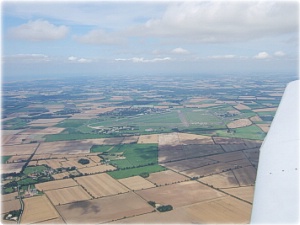
We noted
Hethel airfield on the right-hand side and Steve advised it was the
headquarters for Lotus cars.
We tracked up to North Pickenham and then
skirted the southern edge of Marham MATZ. Norwich then asked us for our
position. "Six miles west of Marham" I advised which was challenged. I
straightened up my map "Correction six miles south of Marham".
Steve
did a FREDA check and changed fuel tanks.
Minutes later we noticed Kings Lynn to the north of us and the canals
to the south.
As we crossed the River Nern a few minutes later Steve
tried to judge where the airfield should be relative to it. Eventually
the airstrip came into view - an oasis of green grass amidst the light
brown fields.
With six miles left to run I requested a radio frequency change to
Fenland Radio on 122.92 who advised runway 26 left-hand was
in use and the circuit height was 800 feet on a QFE of 1003.
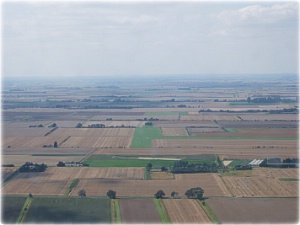
"Ask
if we should join overhead or straight in", prompted Steve. "Report
short final for 26; we have fuel, catering and a westerly wind
of 10-12 knots", the radio operator added.
After a splendid and leisurely lunch in the very busy club house we
headed back to Delta Bravo. The runway in use was still 26 left-hand,
the QFE was 1012 and the wind 250°\16.
On asking where to undertake the
power checks I was advised: "Taxi out left at Alpha to the intersection
of the two runways".
After the power checks at Bravo, with no one else
in the circuit, Steve announced his intention to backtrack 26 for departure.
On saying farewell to Fenland I thanked them for their hospitality
(it had been second to none) and changed frequency to Waddington Radar
on 127.35.
I explained we were routing overhead Waddington ATZ; then through
Doncaster's zone to Eggborough and Sherburn. The ATC gave me a squawk code
of 3605, the Barnsley QNH of 1006 and agreed to a Basic Service.
He advised
we were cleared to transit overhead Waddington ATZ at 3,000 feet but had to
remain clear of Cranwell, Coningsby and Scampton's ATZs.
He then advised he
couldn't detect our squawk. I looked down at the transponder which indicated
a signal or antenna failure. "I'm afraid the transponder's just failed; negative
squawk". "Roger", he acknowledged. I then tried recycling the transponder
several times but to no avail.
Meanwhile Steve kept a very close eye on his GPS en route to Waddington to
make sure we were exactly on track. As we reached the overhead I reported
our position and Waddington acknowledged.
A few minutes later Scampton came
into view and, as soon as we'd cleared the MATZ, I said farewell to a very
seasoned military air traffic controller and contacted Doncaster Radar.
1 - see feedback on article below
I advised we were routing Gainsborough, Haxey VRP, Eggborough and Sherburn;
requested a zone transit and Basic Service. I was given the Doncaster QNH 1013,
asked to squawk 6161 and advised we were clear to enter the zone VFR not above
3,000 feet with a Basic Service.
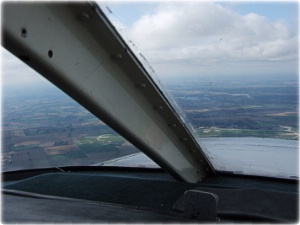
"Doncaster QNH 1013, negative squawk, cleared
to enter zone VFR not above 3,000 feet, Golf Delta Bravo", I responded.
I waited until nearly abeam the Haxey water tower
before making a call to Doncaster, but
realised I should have made contact sooner.
Doncaster Radar asked if Delta
Bravo was just about to enter the zone at Haxey. "Affirm", I replied.
After exiting the zone and reaching Eggborough I said farewell to Doncaster
and hello to Church Fenton who provided a MATZ penetration not above 1,500 feet.
With Sherburn airfield in sight I said farewell to Church Fenton and requested
joining instructions from Sherburn.
The runway in use was 24 left-hand. This
left us momentarily scratching our heads as all joins for the duration of the
Russian aerobatics training, according to the NOTAM, were on the downwind leg.
This would take us straight through the practice area.
After further consultation
we discovered the aerobatics training had finished and we could join overhead.
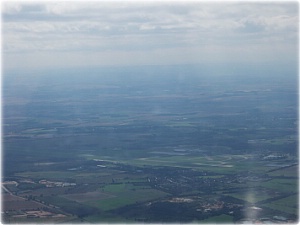
Back on the ground after unloading the plane and heading back to the flight desk,
I noticed Darren and Brian out in the garden.
Last time I saw both of them they
were in the depths of training for their ATPLs. Darren now was only a week away
from completing his training.
Had they enjoyed the aerobatics? Darren quickly explained the training had been
cut short because a friend of the team had been killed during a
display in Moscow that day.
It was a very sobering end to a wonderful day's flying and
impromptu meeting with ATPL pilots Darren and Brian.
Feedback on article
Why not ask the Waddington controller to get that for you?
It could just save a bit of time on another day when the weather
isn't quite as good or there are other time pressures stopping
you from making a prompt call to the controlling unit
The phraseology will go something like this:
"Waddington Radar G-DB requests you arrange a zone clearance for
Doncaster; altitude 2000 ft Haxey direct Ferrybridge; happy to
accept alternative routing"
When he has it you'll hear this from Waddington: "DONCASTER
clears G-DB to cross the zone Haxey to Ferrybridge; altitude
2500 feet DONCASTER QNH 1013 to report entering the zone to Doncaster
Radar frequency 126.225"
You're readback is exactly the line above including
the "Doncaster clears etc."
If you're very lucky he might reply: "G-DB your transit
has been approved contact 126.225 for the clearance"
Worth a go next time!
|